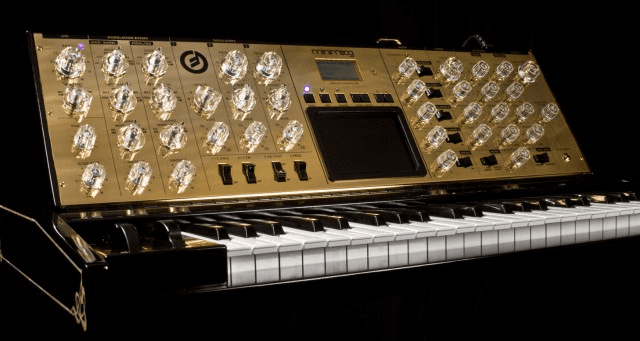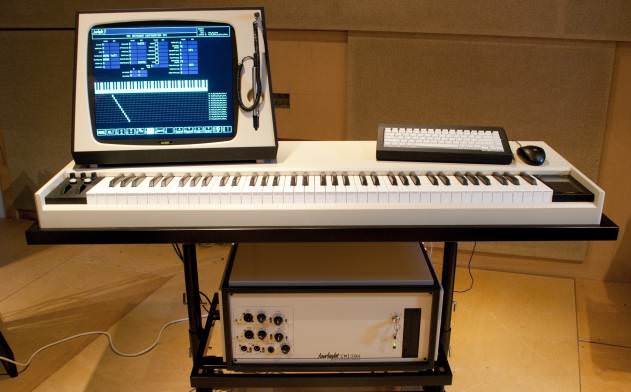Fairlight CMI-30A
The most expensive sampler
Retail price: £14,500
Samplers might not seem very likely to be valuable or desirable in 2013. The development of software samplers like NI Kontakt destroyed the hardware sampler market. Rack units which commanded eye-watering prices in the 90s can now be picked up for a fraction of their original price. Of the few hardware samplers which remain in production, even top-end sampling workstations like Akai’s flagship MPC5000 are relatively affordable. But there’s one major exception to the rule: the Fairlight.
The story starts in the early 70s when Australian synth enthusiasts Kim Ryrie and Peter Vogel set about developing hybrid synthesis methods and enlisted the help of digital synthesis expert Tony Furse. Fast forward a few years through numerous iterations of prototypes and the Fairlight team realised that their chosen approach – digitally sampling sounds to use as the basis of synthesised tones – allowed them to recreate real life instruments with much greater accuracy than conventional synthesis would allow.
The revolutionary Fairlight CMI (Computer Musical Instrument) was actually a lot more than just a sampler. Its combination of sampling, synthesis and sequencing was revolutionary when it went on sale in 1979. The one flaw was that it was staggeringly expensive: about £18,000, roughly the same as the average house price in the UK that year. By the time the new and improved Series III model went on sale in 1985, a full system cost over £60,000.
Mark Thompson of Funky Junk recalls Fairlights “lurking in the corner” of studios throughout the 80s. “My closest encounter was when working with the producer David Lord on Icehouse‘s Measure For Measure album. Iva Davies lived close to Peter Vogel in Australia and used the Fairlight to record his demos. I’ll never forget Iva wheeling the Fairlight into the control room at Crescent Studios and preparing to play his latest demo. Whoops… Iva pressed the wrong button and for 20 minutes we sat there patiently while his last few years’ accounts chundered out of the machine. For those who don’t know, the CMI was based upon an early word processor, and Iva used it not just for demos but for all his office accounts as well. And of course, notoriously, the early Fairlights had no ‘undo’ button – once you’d instructed it to print a set or ten of accounts, there was no going back.
“But when Iva pressed the right button, his demos sounded fantastic, better than many finished records. And there was a quality to the sound that nothing else had offered before or has offered since – a kind of ‘otherworldly’ strength to the samples that made you feel you wanted to leap into the sound and splash around, cloudbusting.
“You know what I mean. It’s that sound that runs through Gabriel’s fourth album, through Kate Bush’s ‘Army Dreamers’, Trevor Horn’s classic productions with Frankie and Yes, Go West, Tears For Fears and hundreds of other 1980s classics. If anything can be said to be the sound of the 1980s, then it must be the CMI.”
Fairlight unsurprisingly went bust when cheaper alternatives to the CMI flooded onto the sampler market, but if you’re looking for a staggeringly expensive sampler in 2013 you’re in luck because a new version is back on sale. The 30th anniversary CMI-30A produced by the original designer’s new company, Peter Vogel Instruments, is a bargain in comparison to the original. Which is a polite way of saying it’s still seriously expensive. At 25,000 Australian dollars (just under £14,500), the new Fairlight is a niche product by anyone’s standards.
For the rest of us, Vogel’s Fairlight apps for iOS are probably a more sensible option.


07.09 AM
Fantastically thorough look into the value behind mouth-watering gearporn. Now time to start saving… ;-(
01.26 PM
Didn’t herbie hancock demo that Fairlight sampler on Sesame Street
01.30 PM
He certainly did, alongside a young Tatyana Ali (Ashley from The Fresh Prince Of Bel Air): http://www.youtube.com/watch?v=oKoisNv1ftw
This video of him showing it off to Quincy Jones is also excellent: http://www.youtube.com/watch?v=n6QsusDS_8A
02.35 PM
no Waldorf Wave?!
02.44 PM
The Wave’s definitely right up there with the best of them.
It’d be great to hear all your thoughts on this from a practical perspective too. As amazing as, say, a CS-80 is, would it necessarily be at the top of your shopping list if you won the lottery? We’ve got a feeling a lot of producers are probably more interested in slightly more affordable classics when it comes to actually making music…
12.09 PM
What about the GX1?
05.01 PM
I enjoyed this article as I continue to with Attack’s interviews and insightful cultural articles..
In addition to the vintage/analogue gear, I’d add some modern controllers to the list which have huge expressive capabilities not available on the mass market, such as polyphonic pitchbend and sensing on multiple axes. For example, the Haken Continuum is US$5,290 (without its case or stand). The newly-introduced ROLI Seaboard Grand is US$8,888.88. Those are the prices of decent used cars.
The CS-80 is an curious example of how performance controllers have regressed in some ways in the decades to come. How it takes something like an Arturia Origin (itself US$3,000) to include all those kinds of controllers. Not as much of a price delta change as you’d expect, given progress with home computers.
While some contemporary tech like touchscreens thrive (tablet market demand, thanks iPads!) and the DJ market has seen interesting plays (Maschine’s rise despite doubters re: the Akai dynasty), more specialized-to-music stuff languishes or is still available at very high prices. I figure there needs to be more popular education for new instruments to resolve part of this chicken-and-egg Gordian knot — otherwise most people, clinging onto the familiar piano form, are too scared to transition to it, keeping prices high.
02.44 PM
Great point, Torley. Things like the Continuum and Seaboard are very niche products, but to a certain type of performer or musician they’re truly desirable – partly because there aren’t many alternatives at any price point.
But you also hit on another interesting point. The touchscreen revolution led by the iPad virtually destroyed another product – JazzMutant’s Lemur controller, which eventually returned, slightly ironically, as an iOS app. And that trend for premium products to be replaced by cheaper alternatives is definitely mirrored in other markets – Maschine undercutting the MPCs, Moog introducing the Sub Phatty and dropping the Little Phatty, and so on (that’s without mentioning software, of course).
There really aren’t actually many super high-end synths around any more. There are products like the Prophet 12, SE CODE, Voyager XL, etc, but while the market for budget (<£500) and mid-range (£500-1000) synths seems to be thriving, anything larger is a much riskier proposition for any company.
Dave Smith acknowledged in our interview that the numbers today are much smaller, and that's despite the fact that synths are much cheaper in real terms than they were back in the 70s. Even with today's advances, the question of whether the market for a truly expressive, powerful performance-based synth in the vein of the CS-80 would still exist is open to debate.
03.17 PM
No GXs? No paper face Serge or Music Easel ? No Wave? No Fenix? And no Synthi 100?
12.54 PM
EMS?
05.01 AM
Wow! My CS-80’s “Slave to the Bass” video is posted here. (Blushes). It is a magnificent instrument. I used to sit in front of PBS Cosmos with Carl Sagan for a mind melding experience in the early 80’s after school. Our console TV had a good 6×9 speaker. Never expected to find a CS-80 of my own. I do not believe 2000 were ever made. So far, all functional CS-80’s are between serial numbers 1000-1800. It is believed that less than 800 were made. Cost prohibitive. There are 45 circuit boards, stuffed to the gills. Over 1200 internal trim pots to calibrate.
08.05 PM
https://www.youtube.com/watch?v=5esV1RiIB8o